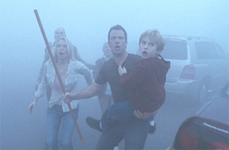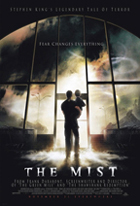The Mist
|  You have to give it to Frank Darabont: When he makes a movie, he makes it all the way. His last film, The Majestic (2001), was intended to be a heart-warming populist fable in the Frank Capra vein, but he took it so far that its saccharine sentimental sweetness left a bad aftertaste in most viewers' mouths. Six years later he has decided to take the opposite route by adapting a Stephen King novella about a supernatural mist and making it even darker and more despairing than the source material. Darabont has adapted King before (1994's The Shawshank Redemption and 1999's The Green Mile), but he's never taken on one of his out-and-out horror stories. With The Mist, Darabont seems hellbent on proving that he can go for the jugular with as little restraint as he went for the heart in The Majestic. Thankfully, the horror genre tends to forgive lack of restraint much better than drama. You have to give it to Frank Darabont: When he makes a movie, he makes it all the way. His last film, The Majestic (2001), was intended to be a heart-warming populist fable in the Frank Capra vein, but he took it so far that its saccharine sentimental sweetness left a bad aftertaste in most viewers' mouths. Six years later he has decided to take the opposite route by adapting a Stephen King novella about a supernatural mist and making it even darker and more despairing than the source material. Darabont has adapted King before (1994's The Shawshank Redemption and 1999's The Green Mile), but he's never taken on one of his out-and-out horror stories. With The Mist, Darabont seems hellbent on proving that he can go for the jugular with as little restraint as he went for the heart in The Majestic. Thankfully, the horror genre tends to forgive lack of restraint much better than drama.The Mist is the first of Darabont's films to be completely and utterly lacking in sentimentality. It is a carefully structured descent into hopelessness, capped off by a profoundly cruel ending that brings to mind the ironic gut-punch at the end of George A. Romero's Night of the Living Dead (1968). Perhaps the times in which we are living, beset with constant news of religious clashes and endless war, are bringing the genre back to a darker place, where supernatural horrors are simply a catalyst for the emergence of human monstrosity. Again, Night of the Living Dead is an instructive comparison because the flesh-eating ghouls outside the farm house, frightening as they were, were mirrors of the fearful human characters inside as they began to feed on each other, first figuratively, then literally. The lesson is that fear brings out the worst in people--that is the true horror. Like many of Stephen King's most effective stories, The Mist features a group of ordinary, small-town people trapped together and besieged by the supernatural. The protagonist is David Drayton (Thomas Jane), a poster artist and all-around Everyman who goes to the supermarket with his young son Billy (Nathan Gamble) the morning after a thundering electrical storm knocks out their power and sends a huge tree crashing through the front of their house. Right before they leave they notice a strange mist coming off the mountains and over the lake toward their home. They think little of it until they are in the supermarket and a blood-streaked man comes screaming toward them, yelling about how something came out of the mist and took his friend. Everyone huddles inside the supermarket as the cold wet fog envelops the building, and for a while there is confusion as to what it is. Is a chemical attack of some kind? A natural disaster? Some form of freak weather? The first clue as to what lies in wait for them comes when a bagboy (Chris Owen) tries to venture outside and is devoured by a swarm of spiked tentacles. Since only a few people witness the event, there are still some naysayers, particularly Brent Norton (Andre Braugher), David's less-than-friendly and highly litigious neighbor. And then there's Mrs. Carmody (Marcia Gay Harden), one of many in a long line of hysterical fundamentalist freaks in Stephen King's stories who quickly begins raving about sinners in the hands of an angry God and how the mist and the primordial beasties within it are signs of the end of days. That this clearly unstable woman is at first brushed off by most people is not surprising; that she eventually begins winning over converts into a growing doomsday cult is frankly unnerving. Darabont slowly cranks up the tension, patiently stringing us along as the trapped characters come to understand the extent of their predicament and the dawning realization of their impending doom. The film is spiked with action payoffs, including a scene in which giant locust-like bugs crash through the supermarket's front windows and another scene in which a few hearty souls venture into the pharmacy next door and discover it has become infested with ravenous prehistoric spiders that have a particularly nasty means of reproduction. Unfortunately, it is in the more action-driven moments that you feel any real sense of letdown, primarily because the special effects are often disconcertingly bad. This is particularly true of the spiked tentacles, which are so two-dimensionally cartoonish that they almost ruin the film's first scene of outright horror. The winged creatures are more realistic, but only when they are outside the windows and slightly enshrouded in the mist. The more we see of the creatures, the less effective they are. However, Darabont overcomes this weakness with the relentless drive of the narrative and his refusal to cave into potential sentimentality. His depiction of what happens when ordinary people are stripped of their civilizing technologies and put at the mercy of each other is a chilling indictment of humanity--a literal anti-Majestic. For those who don't pick up on the subtext, Darabont supplies us with a discussion between a schoolteacher (Laurie Holden) who feels that people are inherently good and a checkout clerk (Toby Jones) who feels that we are inherently insane. The film doesn't necessarily suggest that the clerk is right about everyone, but he does seem to be right about most people. Like he did with The Shawshank Redemption, Darabont follows King's source material very carefully, except that he adds his own ending at the point where King had trailed off into ambiguity. Ironically, both source novellas end with the exact same word--hope--and while the endings of Darabont's two films seem stridently different, they ultimately have the same meaning. In Shawshank, he gave literal manifestation to the redemption of the title, thus making it clear that hope is a powerfully redemptive force. While King left us on the page with a character hoping, Darabont explicitly showed us on the screen that the hope paid off. In The Mist, he does what seems to be quite opposite, leaving us with a horror that is all too recognizably human and then brutally undercutting it with a sudden revelation that renders it immediately meaningless. And, while this gut-punch seems despairing, it is only because the characters finally lost their hope. The characters in Shawshank live because they maintain hope; in The Mist, they die because they lose it, which in Darabont's world, is the real horror. Copyright ©2007 James Kendrick Thoughts? E-mail James Kendrick All images copyright ©2007 Metro-Goldwyn-Mayer |
Overall Rating: 

 (3)
(3)


